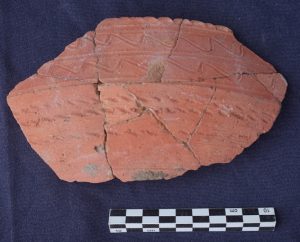Working currently in the earliest strata of House 55 and especially the foundation levels, a considerable amount of older material came up in the last days (including the small fragment of “gilded ware” from Lower Nubia). Dating these ceramic assemblages is sometimes not easy: Second Intermediate Period style of ceramic production continued well into the 18th Dynasty and often one relies on ware and technique to distinguish between residual pieces and products of the New Kingdom.
That Second Intermediate style was not completely passé by the time of the 18th Dynasty, can be nicely illustrated by a common type of carinated bowls. Of various sizes, both in Marl and Nile clays, these often show wavy lines, sometimes in combination with applied ridges and what Stuart Tyson Smith named “pinched ‘piecrust’ rims” (Smith 2012, 397). This type is commonly associated with the Second Intermediate Period pottery tradition in Egypt; early variants are already attested since the late Middle Kingdom in Egypt and Nubia, but these dishes are more common during the Second Intermediate Period.
As noticed in an earlier post, these carinated bowls – by now they are definitely among my favorite types! – are well attested from both on Elephantine and Sai Island. At both sites, they are known from stratified contexts of the early 18th Dynasty, up to the time of Thutmose III.
Today, Oliver was drawing some of the early examples from the phases of use of House 55 – almost identical to the ones he already made drawings of on Sai, stressing again the strong links between the two 18th Dynasty settlements currently being investigated by AcrossBorders.
Reference:
Smith 2012 = Stuart Tyson Smith, Pottery from Askut and the Nubian forts, in: Robert Schiestl / Anne Seiler (eds.), Handbook of pottery of the Egyptian Middle Kingdom. Volume II: the regional volume, Vienna 2012, 377‒405.

